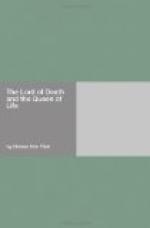They considered this in silence for some minutes. The builder went to another window and looked at Venus, at that time about sixty million miles distant, on the far side of the sun. They were intending to visit “Earth’s twin sister” on their return. After a while he came back to the group, ready with another question:
“If Mercury ever was inhabited, then his day wasn’t as long as it is now, was it?”
“No,” said the doctor. “In all probability he once had a day the same length as ours. Mercury is a comparatively old planet, you know; being smaller, he cooled off earlier than the earth, and has been more affected by the pull of the sun. But it’s been a mighty long time since he had a day like ours; before the earth was cool enough to live on, probably.”
“But since Mercury was made out of the same batch of material—” prompted the geologist.
“No reason, then, why life shouldn’t have existed there in the past!” exclaimed the architect, his eyes sparkling with the instinct of the born antiquarian. He glanced up eagerly as the doctor coughed apologetically and said:
“Don’t forget that, even if Mercury is part baked and part frozen, there must be a region in between which is neither.” He picked up a small globe from the table and ran a finger completely around it from pole to pole. “So. There must be a narrow band of country where the sun is only partly above the horizon, and where the climate is temperate.”
“Then—” the architect almost shouted in his excitement, an excitement only slightly greater than that of the other two—“then, if there were people on Mercury at one time—”
The doctor nodded gravely. “There may be some there now!”
II
A DEAD CITY
From a height of a few thousand miles Mercury, at first glance, strongly reminded them of the moon. The general effect was the same—leaden disk, with slight prominences here and there on the circumference, and large, irregular splotches of a darkish shade relieved by a great many brilliantly lighted areas, lines, and spots.
A second glance, however, found a marked difference. Instead of the craters, which always distinguished the moon, Mercury showed ranges of bona fide mountains.
The doctor gave a sigh of regret, mixed with a generous amount of excitement. “Too bad those mountains weren’t distinguishable from the earth,” he complained. “We wouldn’t have been so quick to brand Mercury a dead world.”
The others were too engrossed to comment. The sky-car was rapidly sinking nearer and nearer the planet; already Smith had stopped the current with which he had attracted the cube toward the little world’s northern hemisphere, and was now using negative voltage. This, in order to act as a brake, and prevent them from falling to destruction.
Suddenly Van Emmon, the geologist, whose eyes had been glued to his binoculars, gave an exclamation of wonder. “Look at those faults!” He pointed toward a region south of that for which they were bound; what might be called the planet’s torrid zone.




